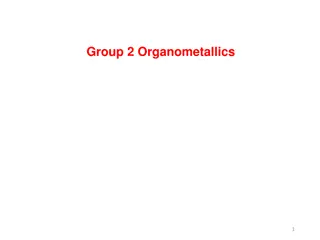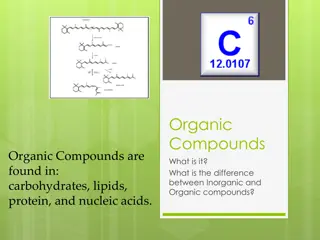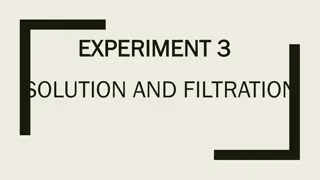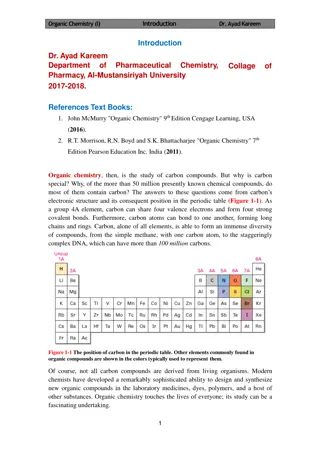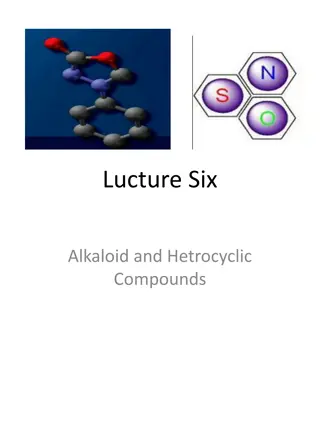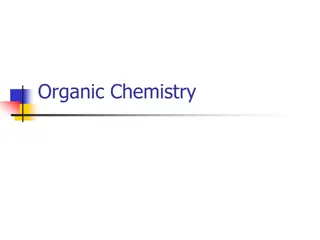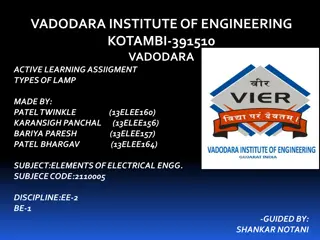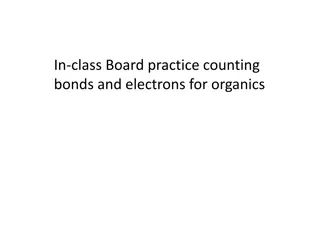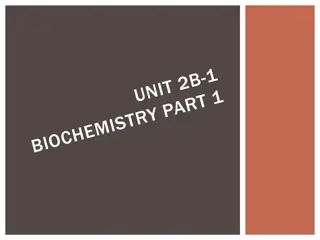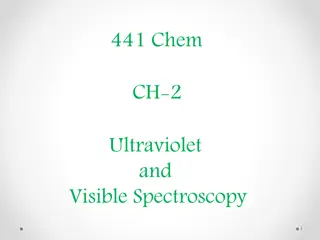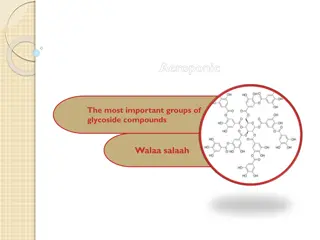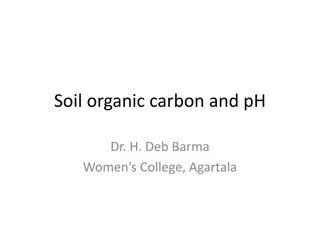Organic Halogen Compounds
Organic halogen compounds are organic compounds containing carbon-halogen bonds and come in various classes such as alkyl halides, vinylic halides, aryl halides, benzylic halides, and polyhalogens. These compounds have distinct physical properties and solubility characteristics that depend on the nature of the halogen atoms. Understanding the nomenclature and classification of halogen compounds is essential for studying their behavior and applications in chemistry.
Download Presentation

Please find below an Image/Link to download the presentation.
The content on the website is provided AS IS for your information and personal use only. It may not be sold, licensed, or shared on other websites without obtaining consent from the author.If you encounter any issues during the download, it is possible that the publisher has removed the file from their server.
You are allowed to download the files provided on this website for personal or commercial use, subject to the condition that they are used lawfully. All files are the property of their respective owners.
The content on the website is provided AS IS for your information and personal use only. It may not be sold, licensed, or shared on other websites without obtaining consent from the author.
E N D
Presentation Transcript
Chem. Chem. 108 108 Organic Halogen Compounds Organic Halogen Compounds Chapter Chapter 6 6
Organic Halogen Compounds An organic compound containing at least one carbon-halogen bond (C-X) X (F, Cl, Br, I) replaces H Can contain many C-X bonds Classes and Names of Halogen Compounds 1-Alkyl halides, R-X A compound containing a halogen covalently bonded to an sp3hybridized carbon. Alkyl halides are subdivided into primary (1 ), secondary (2 ), or tertiary (3 ), depending on the type of carbon to which the halogen is attached.
2- Vinylic halides, C=C-X A compound containing a halogen bonded to an sp2 hybridized carbon. 1-Chlorocyclobutene 3-Allylic halides, C=C-C-X A compound containing a halogen bonded to an sp3 hybridized carbon next to doubly bonded carbon C=C .
4-Aryl halides, Ar-X A compound containing a halogen bonded to an aromatic ring. 5- Benzylic halides, Ar-C-X A compound containing a halogen bonded to an sp3 hybridized carbon next to an aromatic ring.
6- Polyhalogens Haloalkane and Haloarene can be classified on the basis of number of Halogen atoms. They maybe classified as mono, di-, tri-, tetra-, etc atoms in their structure.
Physical Properties of Halogen Compounds 1- Solubility All organic halides are soluble in the nonpolar solvents such as carbon tetrachloride (CCl4) and benzene (C6H6), but they are insoluble in polar solvents such as water.
2- The boiling point The boiling point of the organic halides increase, as the size of the halogen increase. The boiling point also increase regularly with molecular weight. As expected, within a series of isomers, the straight-chain compounds has the highest boiling points, and the most branched isomer the lowest boiling point.
Preparation of Halogen Compounds A Chloro, Bromo, and Iodo Compounds 1. Direct Halogenation of Hydrocarbons (a) Halogenation of alkanes: alkyl halides (b) Halogenation of alkenes
(c) Halogenation of alkynes (d) Halogenation of aromatic ring and alkyl benzenes
2. Addition of HX to Unsaturated Hydrocarbons (a) Addition of HX to alkenes: (b) Addition of HX to alkynes:
3. Conversion of Alcohols: The hydroxyl group of an alcohol is replaced by halogen on reaction with concentrated halogen acid (HX), phosphorus halides (PX3 or PX5), and thionylchlorid (SOCl2).
Reactions of Halogen Compounds Nucleophilic substitution reactions (SN ) Elimination reactions ( E ) Reaction with certain metals to form Organometallic compounds 1- Nucleophilic substitution reactions ( SN) Examples of Common Nucleophiles:
Nucleophile R-X + I- R-X + OH- R-X + -OR' R-X + -SH R-X + -SR' R-X + NH3 R-X + N3- R-X + -C C-R' R-X + -C N R-X + R-COO- Product R-I R-OH R-OR' R-SH R-SR' Class of Product akyl halide alcohol ether thiol thioether amine salt azide alkyne nitrile ester +X- R-NH3 R- N3 R-C C-R' R-C N R-COO-R'
Common basis used in dehydrohalogenation Examples: + OCH2CH3 10 % 90 % + OCH2CH3 90 % 10 %
3- Reaction with certain metals to form Organometallic compounds A- Reduction with Mg and Zn Grignard Reaction
B- Reduction with alkali metals ( Li, Na, or K) Wurtz Reaction Corey-House (Gilman reagent)
Homework 1- Write the structure and name the following compounds according to the IUPAC system. a. Bromoform b. Vinyl bromide c. t.Butyl iodide d. Allyl chloride 2- Complete the following reactions. dil KOH KSH NaI CH2Cl C2H5ONa CH3ONa conc KOH



